Formal Long Black Shirt Dress With Collar Belted High Waist
Scottish evening dress aka highland dress traces its roots back to the seventeenth century and is as diverse as Anglo-American black tie, if not more so. Consequently, this page is only intended to serve as an introduction to the topic. It does so by repeating the descriptions in the Wikipedia "Highland Dress" article (which has improved considerably since the previous edition of the Guide) and enhancing them with some additional clarification and much-needed illustrations.
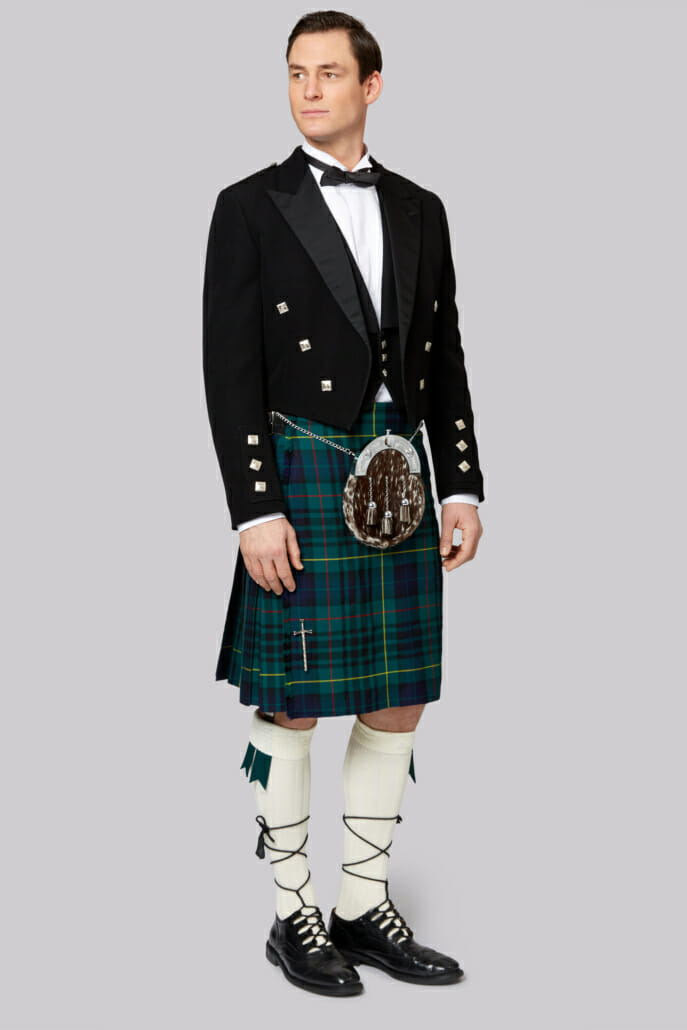
Scottish Prince Charlie Evening Dress
What is Highland Dress?
Highland wear spans the spectrum from morning dress to white tie and from casual to formal making it difficult to cover such an expansive subject. This article will therefore be specifically focused on highland wear black tie, an overview of the history and etiquette. Much like with most formal wear it is steeped in tradition and it is best to know of these traditions and where they come from before trying to assemble an outfit.
Can I wear A Kilt To A Black Tie Event?
The simple answer is yes, but it is a much bolder version, and if you do opt for a kilt, you better get it right.
There are unique obstacles to highland wear black tie as unlike with dinner suits, which look best when you embrace its uniform look highland wear encourages self-expression. If the genius of dinner suits is their monochromatic simplicity than the genius of highland wear is its indulgence in extravagance.
Bright colors and show-stopping sporrans paint a very different picture than the subtle undertones of other nations' black tie. Due to this exuberant styling, it is easy to become lost in all the options, so this article will focus on the simplest most traditional approach to black tie.
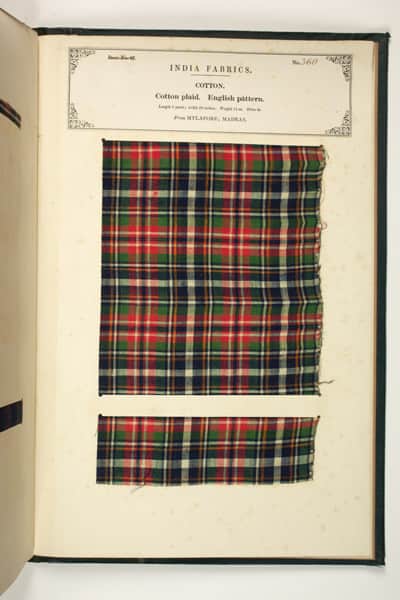
Tartan from 1866 – Harris Museum
What Tartan Can I Wear?
The short answer is any, but the longer answer is less simple.
Whilst it is true that most tartans are affiliated with a clan you don't necessarily have to be a member of that clan to wear that tartan you just have to like it. Clan-specific tartan is a reasonably modern invention as it started with Queen Victoria (Scottish traditions are old enough that the 19th century is considered modern) who after buying Balmoral assigned each clan a specific tartan.
Now a small minority might be confused why you would wear another clan's tartan chances are they won't be Scottish or overly familiar with highland wear and as such more curious than offended.
To learn more about the over 400 tartans, check out this book.
Tartan Restrictions – They Exist!
Whilst most clan tartans are unrestricted and free for anyone to wear, tartans linked to an organization are sometimes restricted. This means that you have to ask the owner's permission before you can have anything made from it. If the tartan is representative of a branch of the military they might ask you if you are a member or have any relatives who are a member and charities might ask for a donation.
Universal Tartans
There are also tartans that have no link to any family or organization and are designed to be worn by anyone. They are called universal tartans and are normally designed by kilt shops so can only be purchased directly from them.
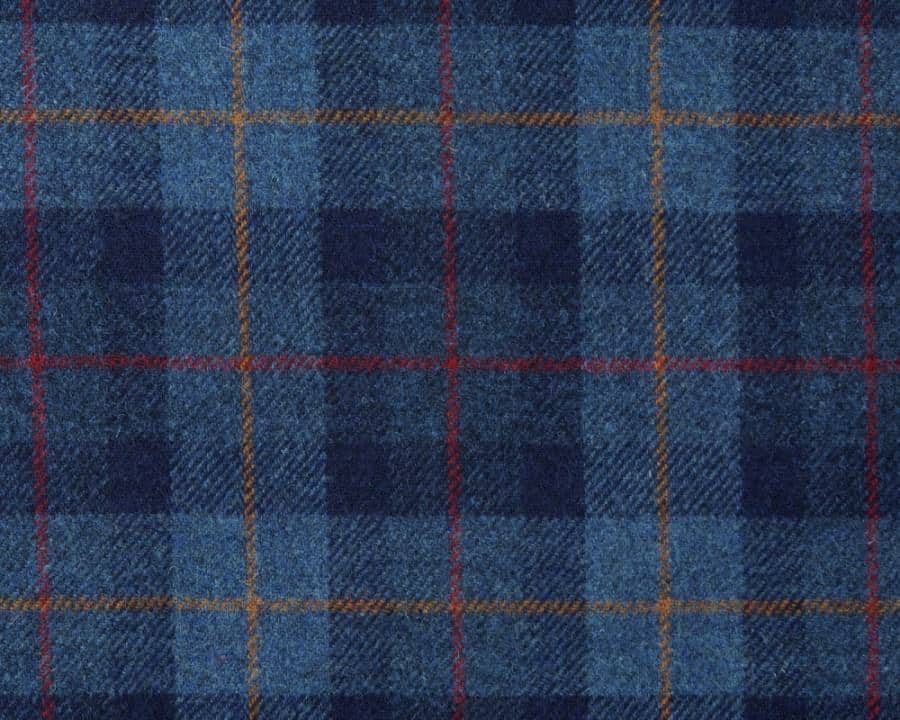
Tartan Tweed
How To Find Exisiting & Register Your Own Tartan?
Due to the intermingling of cultures and people most people have a tartan they can claim, either from their name, location or organization. So if you only want to wear a tartan you have a link to there is probably one out there. If you are curious to find out what your clan tartan is then you could use the tartan registry, which is run by the Scottish government to catalog all registered tartan. This is also where you could register a new tartan that you designed yourself but that can be a costly process.
If you are unsure where to start these are some of the more popular tartans and if it is your first time wearing a kilt you might want to consider going for a more subdued one. If you would like to learn more about the history of tartan and how it can be worn outside of highland dress, then you can consult our guide on tartans.
A kilt outfit for black tie is split into ten categories which will be covered in this article.
Where To Learn More About & Buy Scottish Highland Dress?
For in-depth explanations of the various components of highland dress, we highly recommends Kinloch Anderson's website. They are a sixth-generation family company based in Edinburgh and are official tailors and kiltmakers to the Royal Family which makes them a much more reliable source of etiquette than mainstream rental shops. Scotweb is another excellent visual resource and most images here are taken from their site.
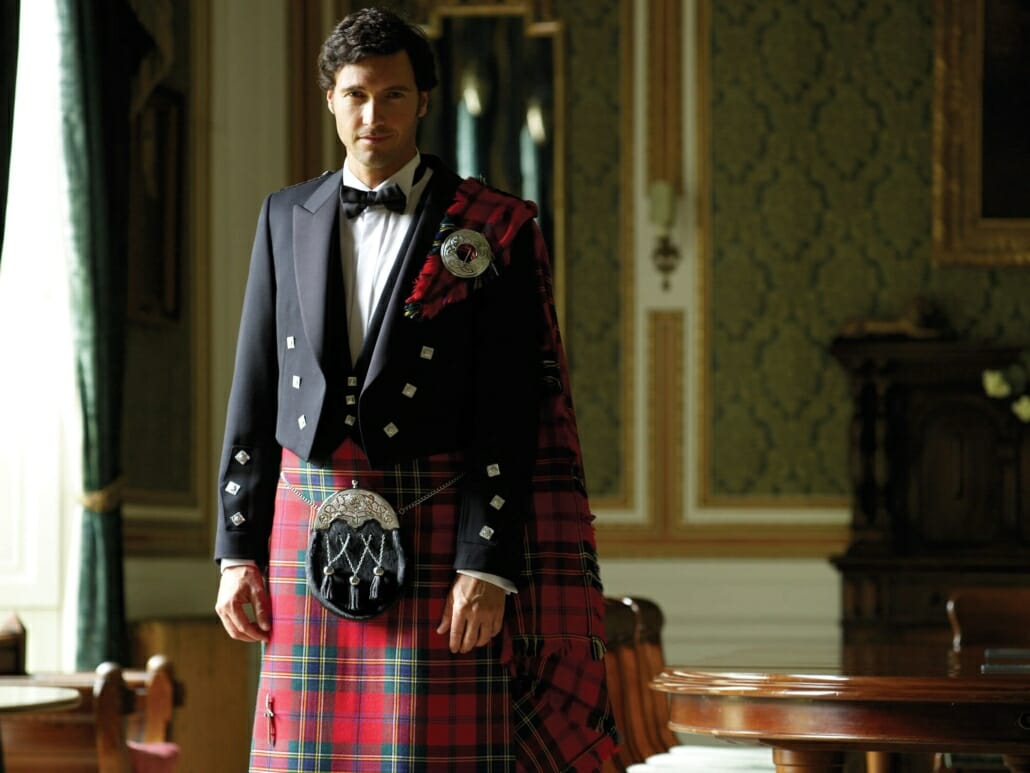
Scottish Highland Dress with kilt and dress sporan
Elements Of A Black Tie Kilt Outfit
A kilt outfit for black tie is split into ten categories which will be covered in this guide.
Kilt
A tailored garment that sits at your natural waist, around belly button height and falls to the middle of your knee. It is made from a heavier wool, the lightest wool would be 13oz per yard but it can get much heavier.
Formal highland wear is a slightly anachronistic idea when observed from a distance and consider its rustic routes. Almost every aspect of an outfit is woven from a heavy wool, a nod to its origin as a utilitarian garment.

Pompeo Batoni, Colonel the Hon. William Gordon (1736-1816), 1766. Edinburgh, National Trust for Scotland
The kilt, for instance, was a simple garment made from one large piece of fabric that the wearer would wrap around their waist and over their shoulder. This garment was called a filleadh mòr and they can still be purchased under their translated name of great kilt.
It was a heavy and sturdy garment designed to weather cold Scottish winters and survive working outside. As this garment is just several yards of fabric you fold pleats into yourself and then wrap around yourself it can be cumbersome to wear and only those looking for a more vintage look should opt for.
Due to the great kilts cumbersome nature, it was modified in such a way to separate the top half from the bottom. This version of the kilt (allegedly created by an Englishman called Thomas Rawlinson) was called the filleadh beag and is very similar in styling to a modern kilt with sewn-in pleats and closed with ties. The kilt hasn't changed greatly since then with the only addition being two to three buckles and straps being added to make the kilt easier to wear.
How To Wear A Kilt? Not Too Low
Regardless of whether you prefer the great kilt or more modern kilt you need to ensure you are wearing it right. The first thing is to make sure you are wearing it high enough. The waistband of the kilt should be at belly button height and high enough that no shirt can be seen between the waistcoat and kilt. The kilt should also be centred so that the centre line running down the length of the kilt lines up with the buttons of your waistcoat. You also want to make sure that the kilt is the right length, above and below the knee can look feminine and as such you want your kilt to land at the knee. An old military tradition says that when you kneel in your kilt it should just touch the ground. But that technique was never used for individual soldiers only garrisons to make the soldiers all look uniform. The only true way to find the right length for a kilt is to be measured by another person. Finally, make sure you are wearing the kilt with the pleats at the back.
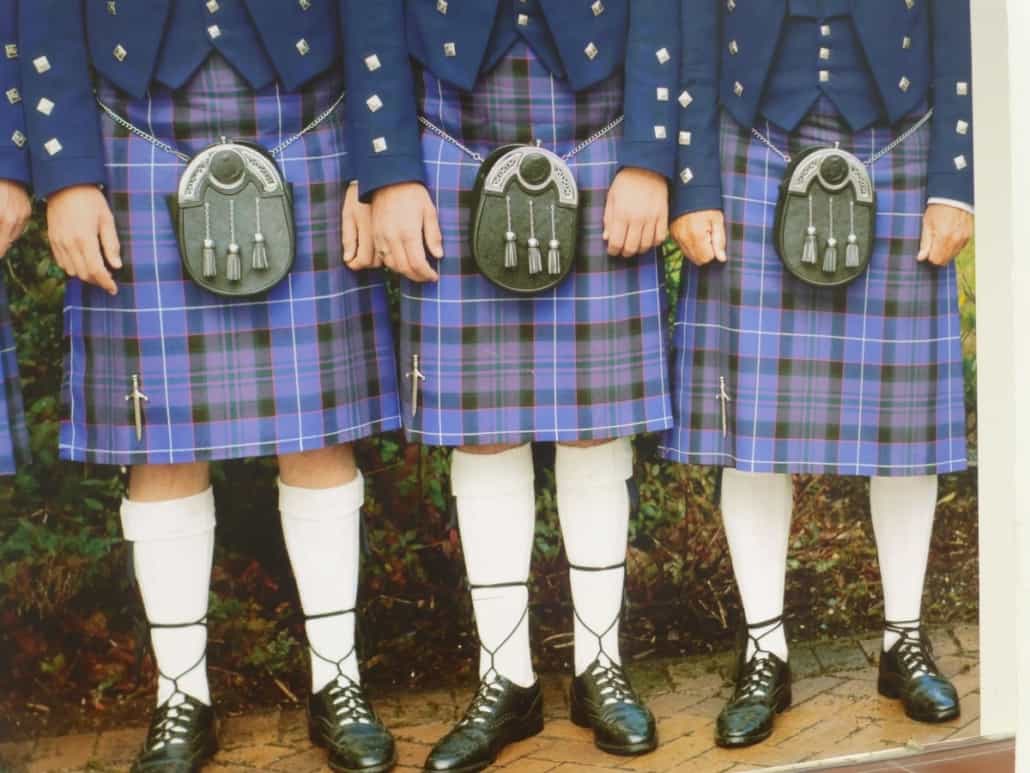
3 matching kilts
Kilt Outfit Buying Advice
There are a few things to look out for when purchasing a kilt and several hallmarks of quality to look out for. The first thing to look for is its method of manufacturing. All new kilts are custom to the individual and therefore it is entirely your choice between the two.
The highest quality kilts would be a handmade kilt from an established retailer. A handmade kilt will flex better and drape the body in a more flattering manner, especially for thinner men or men with a large hip measurement.
You will also get a certain craftsmanship from a handmade kilt that a machine-made kilt can't match, however with that craftsmanship comes a higher price tag.
To create a full kilt outfit, we advise going straight to the source and buying directly from a trusted kilt retailer. Ideally, you would visit in person but that isn't always possible and as such most retailers have a robust online system. Many of these retailers also do bundle deals when you buy a full outfit which helps to lower the cost as kilt outfits can quickly get expensive.
If that is too expensive you could hire an outfit but the fit won't be right and in many instances, the jackets and sporrans will be in a poor condition.
Therefore, many men will either buy a second-hand kilt or an Ex-Hire kilt and then purchase the other items new. An Ex-Hire kilt as it sounds is a kilt that at one time would have been hired out but the shop for any reason has decided to sell on. Due to the robust nature of kilts, they tend to remain in good quality and once bought can be altered to better fit you. The savings from buying an Ex-Hire kilt or second-hand kilt will also free up money to be spent on a new Prince Charlie, new sporran or new accessories.
There are several retailers with good online services such as Kinloch Andersons or McCalls Highlandwear but there are many more and we recommend shopping around.

Prince Charlie Kilt Outfit by Scotsweb
How Much Should You Spend On A Kilt?
Normally you would look to spend £100 (roughly $135) more on a handmade kilt than a machine kilt. When you consider that a new machine-made kilt will cost around £400 (roughly $535) compared to £500 (roughly $670), the £100 isn't as large a leap relative to the total price. If those prices seem rather high, I will discuss less expensive options a little later.
For a full brand-new kilt outfit, it will run from $1500 upwards. If that is too expensive you could hire an outfit but the fit won't be right and in many instances, the jackets and sporrans will be in a poor condition.
8 Yard-Piece Wool
A kilt should also be made from an 8-yard piece of wool (there is a trend towards making kilts out of less fabric but the pleats will be too small or too few so we recommend sticking with the 8 yards) either in a tartan or solid color that is sized to your body.
With deep pleats in the back and two to three buckles. One on the left which secures the kilt in place and one to two on the right which holds the front of the apron up. The extra buckle on the right is called a hip buckle and has become common practice in Scotland, but its necessity is debated. We suggest you add the hip buckle as it makes the kilt sit neater on the body, but it is ultimately down to personal preference.
Leave Yourself Some Time
When buying a kilt, one thing to consider is that as all new kilts are made to order you can expect to wait 6-8 weeks to get one made. Meaning you should purchase a couple of months before your event and if possible order the other items of your outfit at the same time.
Similarly, if you wish to wear a plaid you should order it at the same time and request it to be made from the same cloth as the kilt. It is a long garment that stretches from your chest, over your shoulder and to the back of your knee. A plaid should match the kilt in both color and fabric.
Traditionally a plaid would be worn by a major member of the event or host, such as the groom at a wedding and shouldn't be worn by a guest as it will attract too much attention. There are a few different variants of plaid but as it isn't a necessary garment and only appropriate for a few events it can be skipped.
Kilt Fit & Material
Kinloch Anderson shows how kilt should fit in the video below. According to their website "each kilt is made to measure in our workshop in Edinburgh", which should yield into the proper fit.
Since the kilt is such a simple garment the two biggest concerns should be fit and material. The kilt should fit snug against your natural waist and drape your hips nicely. It shouldn't need a belt or braces to keep upright and the waistband of the kilt shouldn't bag at all but should be flat against your stomach. Kilts can be altered greatly which means once you buy one you shouldn't need to replace it unless you gain or lose a large amount of weight.
The largest change in size we have seen is ten inches, but your mileage may vary. The only trouble with kilt altering, especially larger changes, is that however much you expand the waist you will also expand the hips and vice versa. Meaning unless you gain or lose weight somewhat evenly it could be difficult to alter.
For material, wool is the gold standard but there are options. If you are a vegan namely polyester. Polyester kilts wrinkle easily, have shorter lifespans, stains are there to stay, and they tend to not drape as nicely. Therefore polyester kilts so should be avoided when possible.
Most tartans are woven in Scotland by one of three mills, Lochcarron, House of Edgar and Martin Mills (as a note Martin Mills is English). The wool should be heavy with 13oz being the lightest and 16oz being ideal, anything lighter won't sit properly or sway as well when you are walking. You can find kilts made from a heavier wool, but they are infrequent as they can be uncomfortably heavy, especially for first-time wearers.
Kilt Tartan
In terms of tartan, as we mentioned earlier you can pick from the clans or from an organization. Clan tartans feature different prefixes depending on the design and there are four main prefixes. Ancient, designed to reflect the old way of dying wool and as such tend to be bright and pale. Modern, using modern dying techniques you can achieve a deeper color and as such you can get darker tones.
Dress, comes in both ancient and modern but uniquely features an added cross of white, normally considered more formal than the others by purists. Weathered, designed to look like an aged piece of cloth and as such has even more brown tones than the other tartans. The differences are only cosmetic so if you want your clan tartan, say MacKenzie and it is available in ancient, modern, dress

Welsh Argyll Outfit by Scotsman
Jacket – Prince Charlie, Argyll, Crail & Doublets
For black-tie, there are a few options, but the Prince Charlie is the most popular. It features wide peak lapels faced with silk and pewter buttons looking somewhat like a black mess jacket. A Prince Charlie should be worn with a low cut three-button waistcoat which features self-faced lapels.
Other options would be, an Argyll or Crail jacket which features self-faced notched lapels and a five-button waistcoat. The difference between the two aesthetically is the cuff:
The Crail has a scalloped cuff in line with a Prince Charlie containing of three buttons running vertically up the cuff.
The Argyll features a gauntlet cuff which is a folded back piece of fabric with three buttons in a row
They both feature self-faced notched lapels, epaulettes and two buttons but you shouldn't button your jacket when worn with a kilt.
There is also a selection of doublets that are inspired by the military and as such are very strongly structured with two rows of buttons running the length of the jacket. These are difficult to come by but the Sherrifmuir (the most modern take on a doublet) is readily available and is worn open with a matching squared bottom waistcoat.
Prince Charlie Jacket
The go-to jacket for highland wear black tie is the Prince Charlie. Designed in the 1920s to replace the old heavy doublets and since then have completely eclipsed them in popularity. Aside from those looking for a more vintage-inspired look, the Prince Charlie is the go-to jacket for black tie.
The Prince Charlie looks and fits in a similar way to an evening tailcoat. The key differences are a Prince Charlie features pewter buttons, scalloped cuffs (three buttons in a row sewn onto a patch), epaulets (if you chose to wear a plaid it should be fed through this epaulet) and shorter tails at the back. The jacket should also feature wide peak lapels faced in satin.
A Prince Charlie should fit like an evening tailcoat, close to the body creating a slim but flattering shape. You should show approximately ¼ inch of cuff, though sleeve length is down to personal taste and some men like to show more or less. The tails at the back should be cut shorter than regular tails as to not conceal the pleats of the kilt at the back. The jacket too should be cut short at the front to expose more of the kilt. The jacket can't be closed and will sit open revealing the low-cut matching waistcoat beneath.

Regulation Doublet and Vest in Velvet by Kinloch Anderson
Waistcoat / Vest
Much like with the kilt the jacket and waistcoat should be made from wool. Normally barathea in either black or midnight navy. A Prince Charlie waistcoat should match the jacket in both material and color and feature three pewter buttons in a single-breasted configuration. The waistcoat will also feature a self-faced lapel with a squared-off bottom.
Waistcoat Fit – Avoid Showing the shirt
The waistcoat should fit close to the body but not be tight. The waistcoat should be cut short enough to stop it from peeking out from underneath the front of the jacket. Despite the short cut though you shouldn't be able to see any shirt between the kilt and the waistcoat.
The most common mistake you see when men wear highland outfits is their kilt being worn low with a Prince Charlie and revealing a large swathe of the white shirt. It makes you look disheveled and should be avoided.
Argyll & Crails Waistcoats
Their waistcoats too are interchangeable, they would both be worn with a five-button matching black waistcoat. The other waistcoat option you could opt for with an Argyle or Crail is a matching tartan waistcoat. The tartan should match your kilt and ideally be cut on the cross to create some contrast from the kilt. With a tartan waistcoat, you could either go for tartan covered buttons or matching pewter buttons.
Highland Dress Shirt
For the Prince Charlie jacket, it is considered traditionally correct to wear a wing collar shirt with a covered placket and neither pleats nor a Marcella bib. Whilst most kilt shops will sell these shirts they can be difficult to source elsewhere. Many modern wing collar shirts feature flimsy wings and a collar that doesn't extend far up the neck, so it is advisable to shop around or go for a more vintage-inspired shirt with a detachable collar.
For the other jacket styles, you can wear either a turn-down collar shirt with a covered placket or wing collar shirt. Even though you can find attached wing collar shirts, the starched detachable collars look so much better.
Detachable or Attached Collar Shirt?
Due to the older and more vintage look of highland wear wing collar shirts are preferable to turn down collar shirts. However, when in a pinch it is acceptable to substitute the wing collar for a more modern turn down collar shirt. You should ensure that the placket is covered as buttons are too informal and studs can be seen as busy when mixed with the metal buttons of highland jackets. The ideal shirt with a Prince Charlie then is a wing collar shirt, with covered buttons and no pleats or Marcella bib. If wearing an Argyle, Crail or Sheriffmuir then a turn-down collar is more appropriate, but once more should have a covered placket with no front bib.
Neckwear – The Black Bow Tie
As the name suggests you should go for a black self-tie bow tie and as the silk that faces a Prince Charlie is satin you should wear a black satin bow tie. If you are wearing a wing collar shirt is it important to wear a sized black satin bow tie, without any adjuster.
Sporran
The sporran is the small bag which is worn over the kilt and positioned just below the waistcoat. It was originally a simple leather bag to hold one's belongings as the kilt lacked pockets. Over time though more ornate materials were used until the practical nature of the bag was all but forgotten.
During Britain's colonial days for instance animals from all across the empire were turned into sporrans, including but not limited to lions and kangaroos. Now with better laws protecting endangered species, new sporrans are made reliably and with compassion. However, if one does want to get a more exotic sporran you can occasionally come across vintage sporrans made from such animals.

Mask Sporran
Do I Need A Real Seal Fur Sporran? No
It is worth mentioning that if you don't wear fur for ethical reasons then there are vegan alternatives. They can be harder to come by and less robust than one made from leather and fur but are functional. Even if you aren't opposed to wearing fur it is best to buy a sporran from Scotland as Scottish sporran makers are under heavy scrutiny from national and international law. This ensures that the skins come from ecological sources.
For instance, seal is the most traditional fur that is used but they became protected by EU law in 2009. To ensure that Scottish tradition could be followed the EU courts and the Inuit tribes which harvested most of the seals agreed on a tracking system being introduced. This means that all seal sporrans produced in Scotland can be traced to the source. Sporrans outside of Europe aren't held to the same standards and the animals could be poorly treated and subjected to cruelty.

Dress Sporran
Dress Sporran vs. Mark Sporran
There are two types of sporrans which can be worn with black tie traditionally, the full mask sporran and the dress sporran.
The full mask sporran has the head of the animal incorporated into the design; this creates a level of opulence that fits the black-tie vibe. On the other hand, the full mask is a very polarising design due to its unique look. The head of the creature can be seen as morbid and can make people uncomfortable. They will also carry a higher price tag than the dress sporran due to the added work in creating a full mask compared to a dress sporran.
For formal occasions, most men will wear a dress sporran. The dress sporran is a lot more subtly styled in comparison to the full mask. The dress sporran has a metal top called a cantle attached to the fur bag.
Sporrans will also feature a few tassels on the front of the bag normally three. These will be three metal chains leading to a metal bell which houses a ball of the fur. As sporrans are made of natural materials there made be unique colorations to the skin and I would advise searching out these more unique skins. Most sporrans are made of pewter, either chrome or matt and as with most metals, it is advisable to match the metal and finish with any other jewelry you're wearing.

Sword Kilt Pin by Scotsweb
Kilt Pin
A Kilt Pin is a small pin worn at the bottom of the kilt to add weight to the front apron to prevent the wind from blowing it open. In a formal setting, you should match the metal of your sporran to your kilt pin (normally pewter) and your cufflinks.
You could go ornate or simple and the pin could feature a precious or semi-precious stone if you desired. If you do go for a colored stone then ideally it would be a color from the kilt.
Kilt Flashes
Flashes are little swatches of fabric which poke out from under the top of your socks. So when you wear highland hoses the top part of the sock is folded over creating a head and a pair of garters sit in them. They come from a time when spare pieces of fabric were used to hold your socks up and now are less needed and purely aesthetic. When you buy a new kilt the maker will normally make you a pair of flashes at the same time from the matching tartan. Matching tartan flashes are the best way to go but you could also go for solid flashes, normally a color from the kilt.
In any case, they should be made of wool and either the same tartan as the kilt or a solid color from the kilt.
Kilt Hose
Kilt hose are long socks worn just beneath the knee. They are normally made of wool (can be made of cotton if you have an allergy or tend to overheat). For black-tie white or cream is the most advisable, though checked socks are more traditional. However, they are rarer now and very expensive. All kilt shops will stock formal kilt socks in multiple sizes and are very easy to come by.
Sgian Dubh
Tucked into these socks is a sgian dubh which roughly translates to black knife. It got this name due to it being carried in a sling near your armpit and would discolor from being exposed to the environment and sweat. When you would enter someone's house though, to show that you are friendly you would remove the knife from your sling and tuck it into your sock. This tradition has lasted into the 21 st centuries with people still regularly carrying sgian dubhs when wearing a kilt. A more formal sgian dubh would be simply designed, normally with a wooden handle and silver or pewter detailing.
As a note you should always research knife laws wherever you plan to wear a sgian dubh and if in doubt of the legality to forego the knife. Also, if you are planning on drinking alcohol and won't be fit to drive home then perhaps you should leave your sgian dubh at home. Most modern blades are blunt and just for show but it is still better to err on the side of caution.
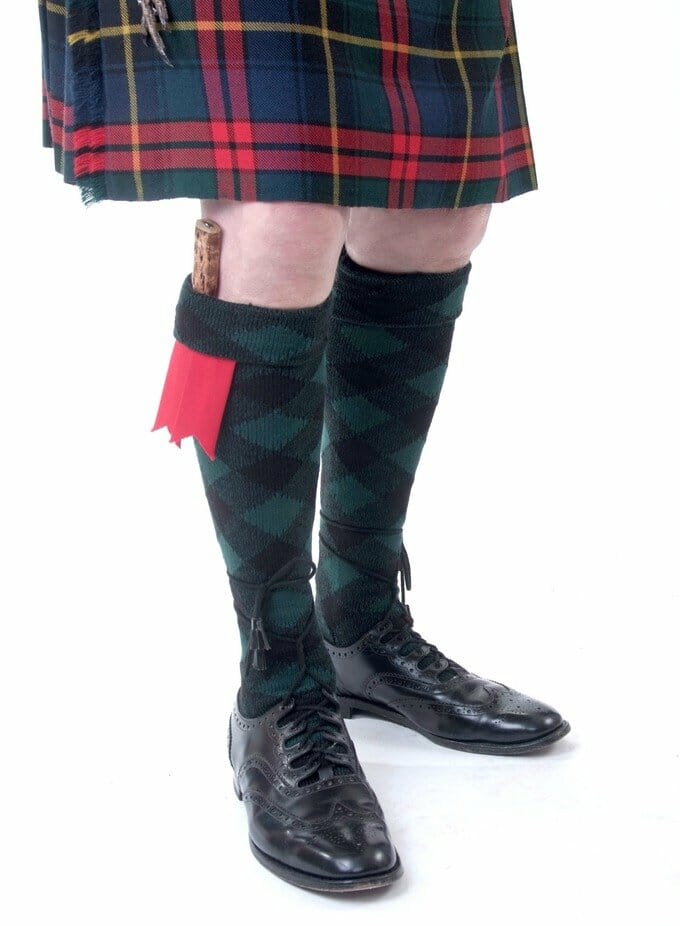
Diced kilt hose with garter flashes. The shoes are ghillie brogues
Ghillie Brogue Shoes
Ghillie brogues are the formal shoes you would traditionally wear when wearing a kilt outfit. Even though you can also find them in other colors such as brown, for black tie, black leather ghillie brogues are essential. These are shoes that feature broguing and an open lace system which is tied up your leg.
The laces help to break up the monotony of the kilt hose and as such are preferable to traditional oxfords, but your oxfords are becoming more common. Either way, unlike with most black-tie outfits your shoes should be brogues and well shined but not patent leather. It is very easy to find ghillie brogues and the ghillie brogues made by Loakes are probably the biggest bang for your buck on the market currently.
Highland Dress Overview: Black-Tie Equivalent
According to Wikipedia, Scottish Highland dress is often worn to black and white tie occasions, especially at Scottish reels andcéilidhs (traditional social dances). Customarily, the black-tie equivalent consists of the following:
| jacket | • • | black barathea kilt jacket: · Argyll, Braemar jacket (least formal, see note following) · Prince Charlie jacket (the most popular)· regulation double alternatively, a black mess jacket there is some contention about whether the Montrose doublet or Sheriffmuir doublet are too formal for black tie; they should be worn with the accompaniments described for white-tie equivalents. |
| kilt | • | kilt |
| waist covering | • • | matching waistcoat, low cut and fastened with three Celtic buttons Wikipedia also states that the waistcoat can be tartan but that option seems to apply only to the Argyll jacket or Sheriffmuir doublet |
| shirt | • | white shirt with shirt studs, French or barrel cuffs, and a turndown collar (wing collars are reserved for white tie in most locales) |
| neckwear | • | black bow tie |
| footwear | • • | evening dress brogues: ·buckle brogues (tongue-less brogues closed with a strap and decorated with a buckle on the toe of the shoe) are most formal · ghillie brogues (tongue-less brogues with long laces that wrap around the lower leg and tie above the ankle) are less formal dresskilt hose (knee-length wool socks): ·diced pattern (broad crisscrossing diagonal stripes of two different colors) or tartan patterns (to match kilt) are most formal; note that red diced patterns are for members of the military · solid-color hose are less formal; note that white and off-white hose are often seen but are deplored by some |
| accessories | • • • • | silkflashes (a pair of decorative pointed vertical strips of fabric attached to elastic sock garters) or silkgarter ties (traditional sock garters made from fabric that ties around the calf) dresssporran (decorative pouch worn at the front of the kilt) with silver chain black, silver-mountedsgian dubh (a small ornamental knife tucked into the kilt hose) optionaldirk (an ornamental cut-down sword) |
| outerwear | • | Highland bonnet with crest badge (only suitable out of doors) |
Regarding the Braemar jacket, Scottishtartans.org reports that "Braemar" is actually just a style of cuff (specifically, a three-button patch cuff) that can be applied to any kilt jacket. They are typically seen on Prince Charlie jackets but are sometimes seen on Argyll jackets thus leading some makers to refer to the latter as Braemar jackets. Even more confusing, "Argyll" refers to both a style of jacket and a style of cuff (specifically, a gauntlet cuff). While the jacket and eponymous cuff are usually matched together it is nonetheless possible to have an Argyll jacket with Braemar cuffs or a Prince Charlie jacket with Argyll cuffs.
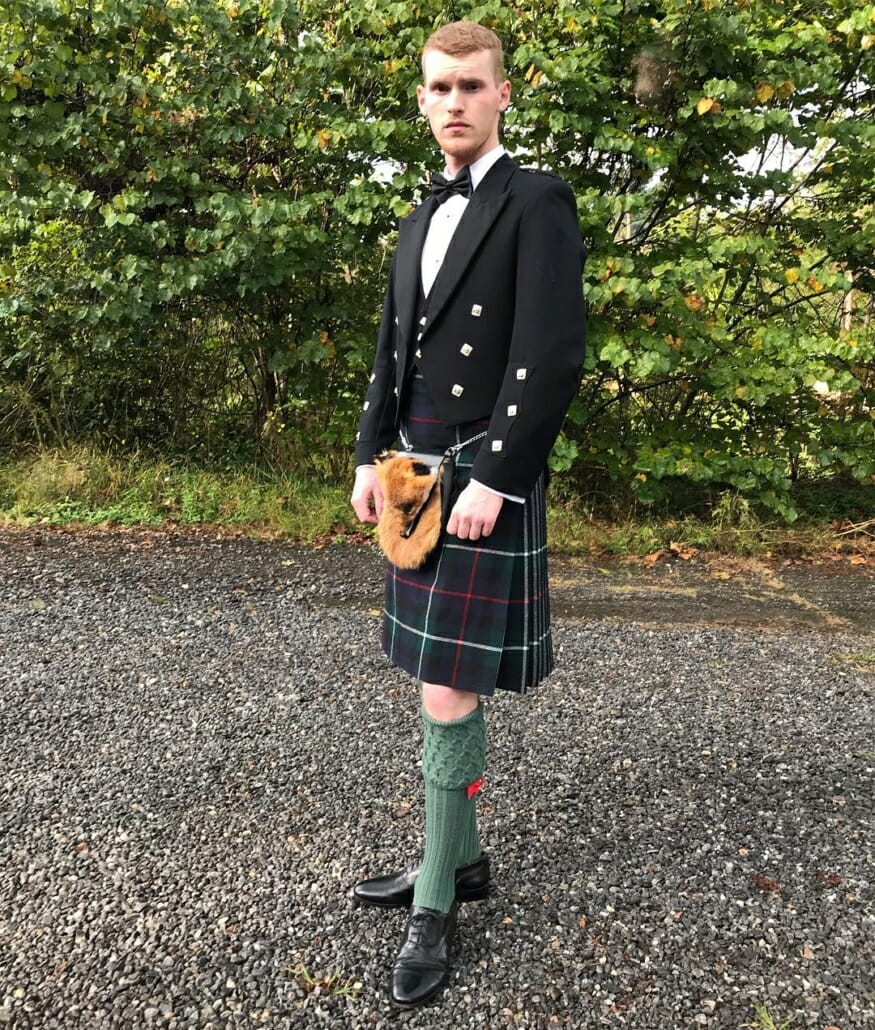
Young chap in scottish highland dress
Highland Dress: White-Tie Equivalent
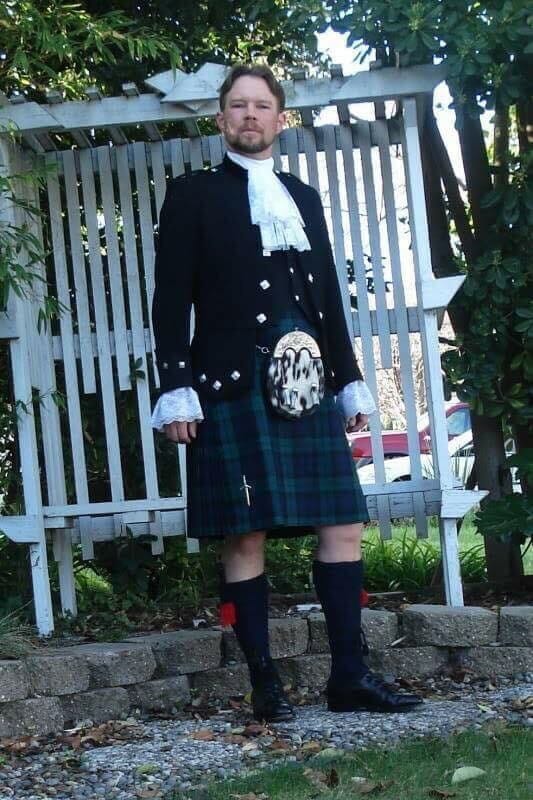
Scottish Highland White Tie Equivalent
The more elaborate forms of Highland Dress are reserved for white-tie occasions although it is actually more common to see Highland Dress black-tie equivalents at these occasions.
| jacket | • | formal kiltdoublet in barathea or velvet: ·regulationdoublet · Montrosedoublet · Sheriffmuirdoublet · Kenmore doubletall are suitable in a variety of colors |
| kilt | • | kilt |
| waist covering | • • • | waistcoat in white marcella, tartan (to match the kilt), or the same material as the (regulation or Sherrifmuir) doublet no waistcoat is worn with the Kenmore doublet (nor, presumably with the Montrose doublet as it is double-breasted); instead, Kinloch Anderson says these two doublets are usually worn with a belt Kinloch Anderson says that the Sheriffmuir should be paired with a waistcoat that closes with seven Celtic buttons |
| shirt | • • | white stiff-front shirt with wing collar and white, gold, or silver studs and cufflinks for the regulation doublet white formal shirt and optional lace cuffs for the Montrose, Sheriffmuir, and Kenmore doublets |
| neckwear | • • | white lacejabot (a cascade of lace or ruffles on the breast of a garment) with the regulation doublet a black silk or white marcella bow tie may be worn in place of the jabot (highland wear often includes a black bow tie even at white tie events) |
| footwear | • • | black buckle brogues diced or tartan kilt hose |
| accessories | • • • • • • •• | studs and links as noted under "shirt" for regulation doublet formal kilt pin silk garter flashes or garter ties silver-mounted sporran in fur, sealskin, or hair with a silver chain belt black, silver-mounted, and jeweled sgian dubh optionalfly plaid or shortbelted plaid (a square piece of cloth in the same tartan as the kilt attached to the left shoulder of the jacket with a decorative broach) |
| outerwear | • | Highland bonnet with crest badge (only suitable out of doors) |
Lowland Dress
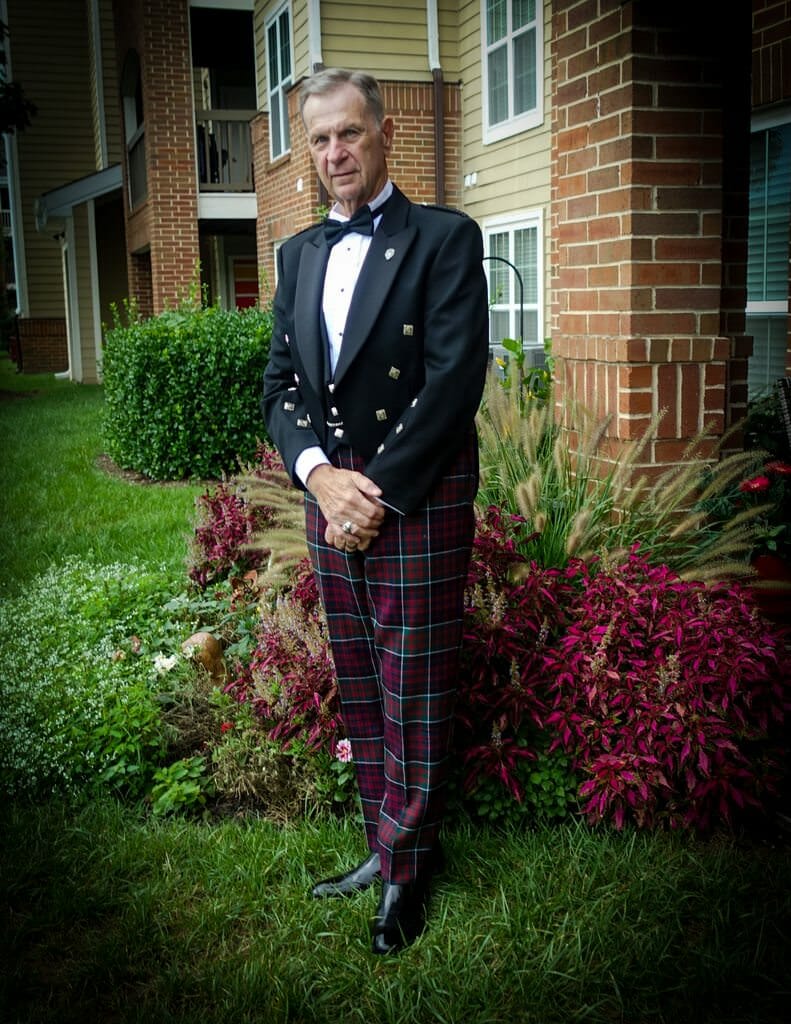
Scottish Lowland Evening Dress with tartan trousers
The traditional Lowland equivalent of black tie is tartan trews(tight-fitting high-waisted trousers with fishtail back worn with suspenders as an alternative to the kilt) combined with a standard dinner jacket and cummerbund or a Prince Charlie jacket. Trews are often worn in summer and in warm climes.
Trews are versatile and can also b e worn with regular classic black tie attire. Because trews are quite loud, we rec ommend toning down the rest of the outfit if you do wear trews as otherwise, your outfit might look busy. Also unlike with a kilt where heavy fabrics are best with trews light weight tartan is best to avoid overheating and itchiness.
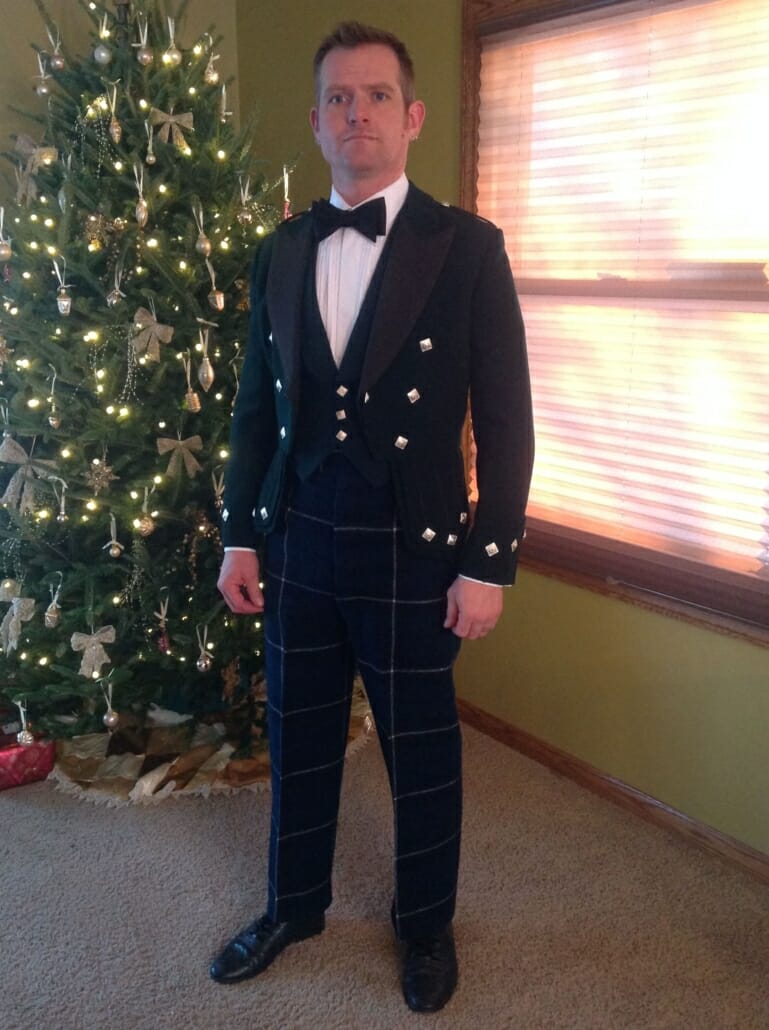
Highland Dress with Tartan trousers instead of kilt
Traditional white-tie Lowland dress is a variant of standard white tie that substitutes tartan trews for the usual full-dress trousers and may include a suitable kilt jacket or doublet instead of the tailcoat.
Formal Long Black Shirt Dress With Collar Belted High Waist
Source: https://www.gentlemansgazette.com/tuxedo-black-tie-guide/advanced/scottish-highland-dress-irish/
0 Response to "Formal Long Black Shirt Dress With Collar Belted High Waist"
Post a Comment